Display ads are one of the most popular ways to get your company’s name and products in front of potential customers — and paired with organic efforts, they can help you achieve your inbound marketing goals in record time.
But before you dive in and start creating your first display ad campaign, there are a few things that you should know — including what they are, how they work and how to use them effectively to maximize your marketing return on investment (ROI). Let’s get into it!
What Are Display Ads?
Display ads are visual, engaging forms of digital advertising placed on third-party websites that incorporate video, image or text elements to market products or services. They’re designed to attract the attention of online consumers, drive engagement and encourage conversions.
Here’s the run-through on the most common types:
- Banner ads: These are the most common form of display ads. They typically take up a rectangular space at the top or bottom of a web page and include an image, headline, description and call to action (CTA).
- Native ads: These are the types of display ads that blend into the design of a web page, making them look like organic content. They’re often placed in between paragraphs or next to images and videos.
- Interstitial ads: These are full-page ads that appear before or after a user navigates to another page. They’re popular in mobile apps, including games and social media.
- Responsive display ads: These are ads that automatically adapt to different screen sizes and are designed to fit any device.
It’s worth noting that these ads are different from paid search ads, which appear when potential customers actively look for your offering on Google rather than when they’re browsing across different sites. The advantage of this method? You can reach new potential customers!
Display advertising can be found in articles, videos and high-traffic areas of websites and, typically, they’re published through the Google Display Network because it has the capacity to reach over 90% of internet users worldwide.
Moreover, they’re highly effective for launching new products or promotions, as they can reach people across 35 million websites and apps. And with optimized targeting, you have the capacity to get your message to the audience segments that are most likely to convert — all without affecting your total spend on bids or the cost per customer. That’s because Google display advertising campaigns leverage machine learning solutions to optimize for targeting, bidding and conversions, meaning they’re carefully engineered to provide maximum efficiency.
How Can You Create a Display Ad?
A successful display ad campaign is the result of careful planning and thoughtful execution. You need to know who your audience is, what they want and how to reach them. And once you’ve done that, it’s time to create relevant ads and a compelling display campaign that speaks directly to their needs and interests.To get started, create a new campaign through your Google Ads account and select a goal. You can set this to drive sales, leads and website traffic, or increase brand awareness and reach.
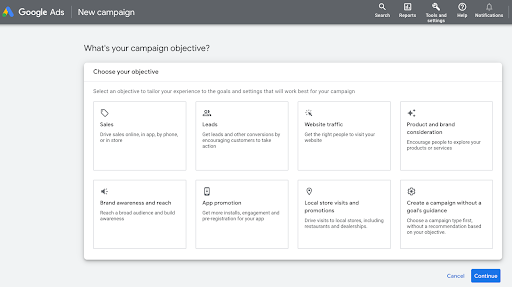
Next, you’ll set the campaign’s settings — including how, where and in which languages your ad will show up.
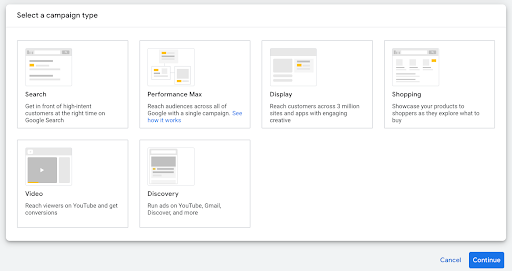
You’ll also need to select a budget and a bidding strategy, which determine the frequency with which your ads will show and how your budget is spent based on your campaign goal.
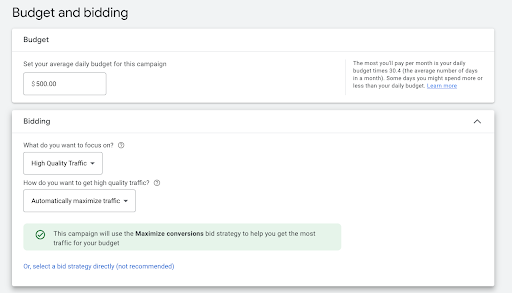
Now, perhaps the most important part for an advertiser: choosing a targeting strategy. You can use Google’s optimized targeting to find the best-performing audience segments, enhance them by adding targeting symbols, or simply utilize your current data segments.
Finally, upload your assets and review your campaign. Make sure everything looks and reads the way you want it to, then launch!
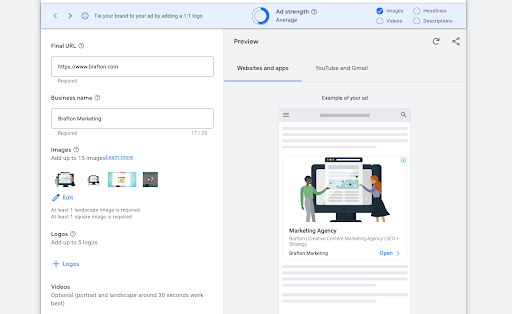
Here are some best practices to keep in mind:
- Use bold colors and graphics: Display ads are designed for quick viewing, so you only have a few seconds to grab the user’s attention. Use bold colors and graphics to make sure your message stands out.
- Be concise: Don’t try to cram in too much information. Your ad copy should be like an elevator pitch — it should tell users what you do and why they should care in just a few words.
- Focus on your unique selling proposition (USP) or value proposition: This is what makes you different from your competitors. It’s what makes people want to buy from you. It’s also what will help you stand out in a crowded market, and it should be included in all of your marketing materials. For your display ads, try to sum up your USP in a single sentence.
- Include a strong call to action: What do you want the user to do? Is it to visit your website or sign up for a newsletter? Include a strong call to action that clearly tells users what they should do next.
- Don’t forget to include your brand name and logo: You want to make sure your brand is clearly visible in display ads by including colors that users recognize. This will help them identify your business — and remember it when they see something similar on other sites or in Google search results.
Subscribe to
The Content Marketer
Get weekly insights, advice and opinions about all things digital marketing.
Thank you for subscribing to The Content Marketer!
Examples of Excellent Display Ads
Good-looking, attractive ads are more likely to get clicked than poorly designed or boring ones. Here are some examples of effective display ads:
1. LensCrafters

Switching back and forth between regular lenses and sunglasses is one of the most common frustrations for eyeglass shoppers. This ad from LensCrafters shows how the company has solved this problem with its Transitions® product line.
Now, what makes this banner ad so effective?
Firstly, it’s visually appealing. The ingenious use of color and graphic elements makes it easy for users to understand what this product does. Secondly, there’s a clear call-to-action to get potential customers in the store, where they can have a personalized experience and get offered other products as well. Finally, the display ad is effective because the copy shows confidence in the company’s product line. It doesn’t try to oversell the product or make unrealistic claims about its benefits. Instead, it simply tells the truth: that this product will help users avoid having to switch their glasses every time they go outside.
2. Progressive Auto Insurance
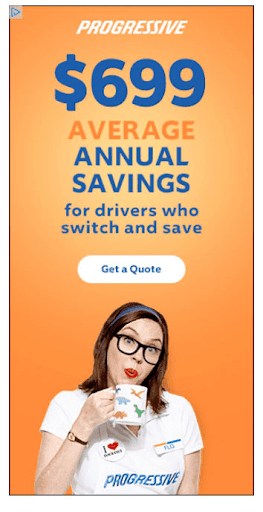
Mandatory auto insurance is a legal requirement for drivers in the United States. It’s also a major expense for many people, but most don’t take the time to actively shop for the best possible coverage at the lowest possible price.
With this display ad, Progressive Auto was able to reach potential customers whilst they were browsing online, not necessarily looking for a new insurance policy, but still, those people may have realized they needed one — exemplifying how display ads help brands reach new customers in a different way that a search ad would.
The big and bold number at the top indicating average savings is a great way to get the conversation started, and the invitation to get a quote serves as a clear CTA that makes users aware of the fact that they could do so right there on the site. In addition, the use of a real person — especially one as recognizable as Flo, Progressive’s recurring cashier character since 2008 — is a clever move as it humanizes the brand and reinforces viewers’ trust in the company when exploring suitable insurance policies.
3. Air France
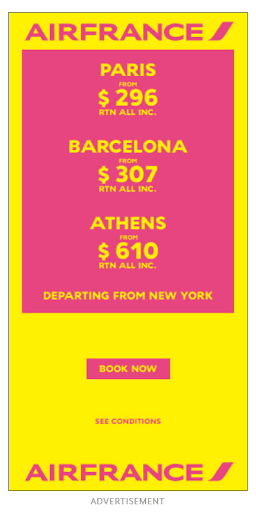
Who doesn’t like to travel? And who doesn’t like a good deal? The truth is, most people can’t wait to get away from their desks and explore the world, but they also don’t want to spend a fortune. Air France understands this and capitalized on it with this targeted display ad.
By leveraging back-end scripting and Google’s location targeting capabilities, the brand was able to capitalize on programmatic display advertising by featuring different flight deals to users based on their location. In this case, the flights were departing from New York, but several different versions of the ad exist.
The copy is simple and gives enough information to entice users into booking a getaway. After that, potential customers need to click through to get more information about the offer as well as prices for their desired dates. Moreover, although the bright colors are not typically part of Air France’s identity, they do an amazing job at catching the user’s eye and making them take notice – which is essential for display ads, especially considering ad placement and competition.
4. Google

Since display ads don’t come up when people are searching for a specific keyword, but rather at random times while they’re browsing, it’s important to make them stand out. In this case, Google achieved this by instilling a sense of urgency.
This display ad example reads “ends tomorrow” and “best deal of the year” to let users know that they had to take action soon or risk missing out on the opportunity. It’s simple and straightforward, but by displaying the regular price for comparison, users are able to see the cost of not clicking through.
Furthermore, the “Buy now” CTA button in blue stands out from the rest of the ad and draws the eye. Even if a user had no interest in purchasing a Google Nest Mini, they would be able to see that this was a limited-time offer — and therefore worth their attention.
5. Uber

For many city commuters, the biggest headache is dealing with unreliable public transportation or being late to work because they missed a train. Uber helps ease this burden, and they created this clever display ad that highlights their USP in just 5 words.
Their logo is prominently displayed in the top left corner of the ad, which is great for brand awareness. Additionally, the connection with a real person makes it relatable to users. Consumers can picture themselves in this uncomfortable situation and feel a need to click on the CTA button — making them much more likely to convert.
6. Sonic
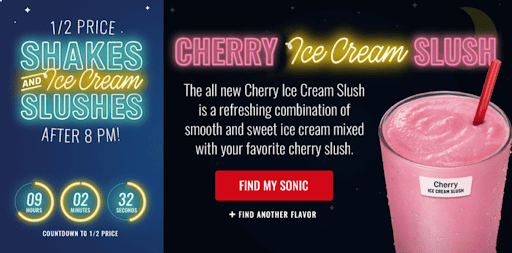
Night cravings can be a real problem for some people, and it’s something that Sonic knows all too well. That’s why we’re bringing back this fun and engaging rich media display ad from 2019 — which they created to promote a 50% off deal on shakes and ice cream slushes after 8 p.m. (it’s too good to let go!).
There are a few intriguing elements to this ad, but by far the most interesting is the neon-colored countdown based on the user’s location. In addition, the “Find my Sonic” button in red contrasts the rest of the ad, effectively motivating browsers to find their closest Sonic and try the new flavor.
Although this ad format is complex, the messaging is clear and the interactive features are not overwhelming. This is an excellent example of a well-executed rich media ad that will appeal to the target audience and encourage them to take action.
How Display Ads Work with Your Broader Marketing Strategy
Digital marketing is an intricate ecosystem, and with so much competition, it’s more important than ever for companies to use multiple types of advertising to reach their target audience. While display campaigns can be effective on their own, they work best when used to complement other forms of digital advertising practices such as pay-per-click and search ads. This way, you can ensure your best chances of staying top-of-mind for consumers and creating a consistent brand experience across channels.
Display ads are the closest thing we have to traditional print advertisements on the web. They allow you to reach your audience in a similar way as print ads, but they have the added benefit of being digital. This means that you can use them on any device and measure their performance using unique metrics such as impressions, clicks and conversions.
What’s vital is that before launching a display advertising campaign, brands set an achievable goal and develop their ad accordingly. This ensures that the strategy being employed is coherent with the brand’s overall marketing goals and will lead to a positive ROI.
So, when it comes to display ads, there are 3 key strategies:
1. Site Placement Advertising
This strategy involves purchasing space on a website and then placing an ad in that spot. This can be done by either targeting specific websites or by using a programmatic platform to buy ad space from multiple sources at once. The idea behind site placement advertising is that if you place your ads on high-traffic sites with relevant content, users will be more receptive to the brand.
2. Contextual Advertising
Contextual advertising takes into account the content on a website and then serves an ad that’s relevant to that content. For example, if you visit a travel blog and there are display ads for hotels or flights on the side of the screen, those ads are considered contextual. This is one of the most effective types of display campaigns because it makes it easy for brands to target users with relevant messaging.
3. Remarketing
Remarketing is a strategy that allows you to show ads to users who previously interacted with your brand. For example, if a user visits your website and leaves without purchasing anything, you can use remarketing to show them ads for the product they were looking at. This approach tends to be particularly successful because it allows brands to build strong relationships with potential customers and retain their attention.
Winning Display Ads Provide Value to the User
No matter what type of display advertising you choose to implement, it’s important to remember that the best campaigns are those that are relevant and useful to users. If you can provide something valuable in exchange for their attention, users will be more likely to engage with your brand and convert into customers.





